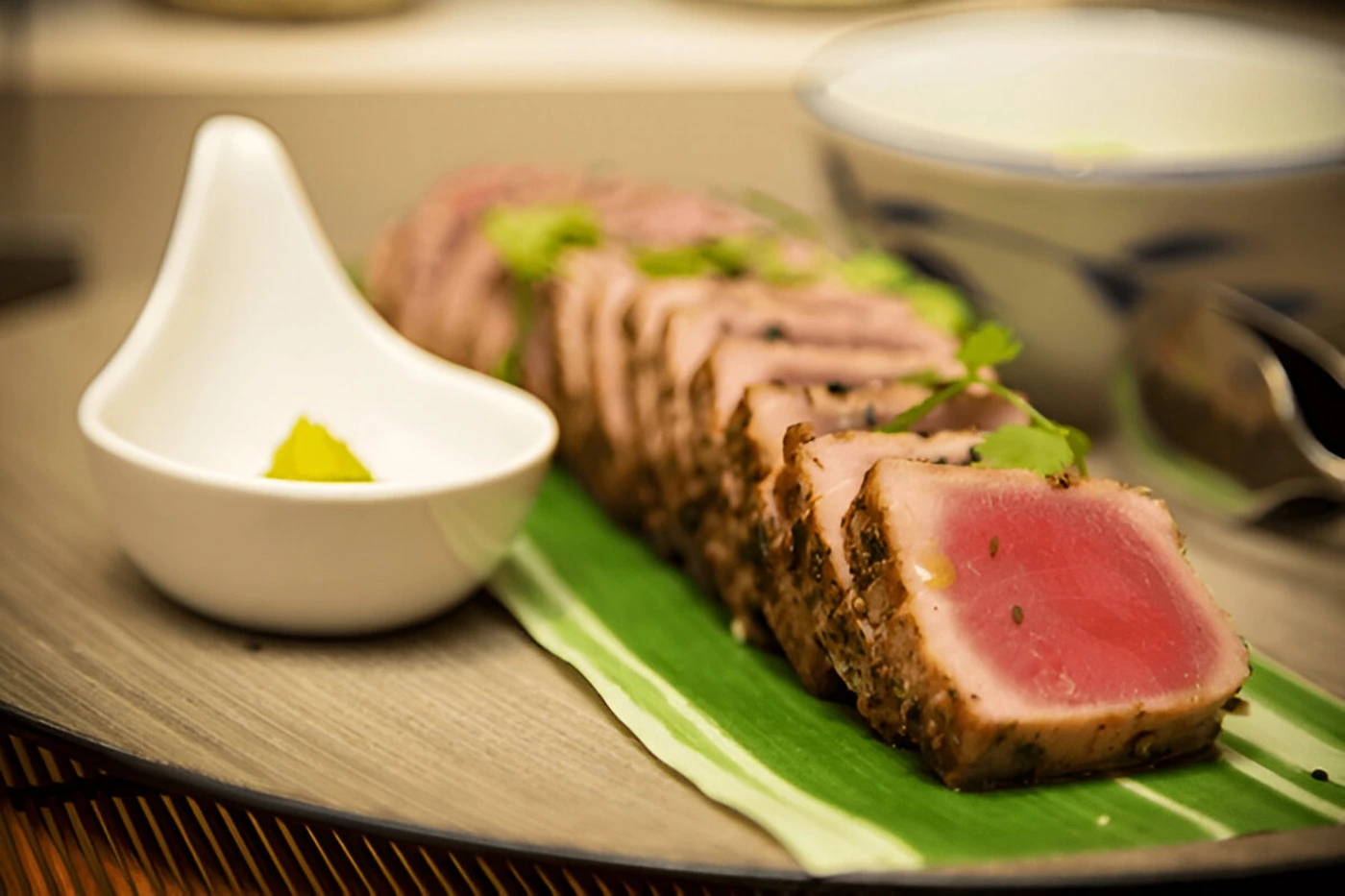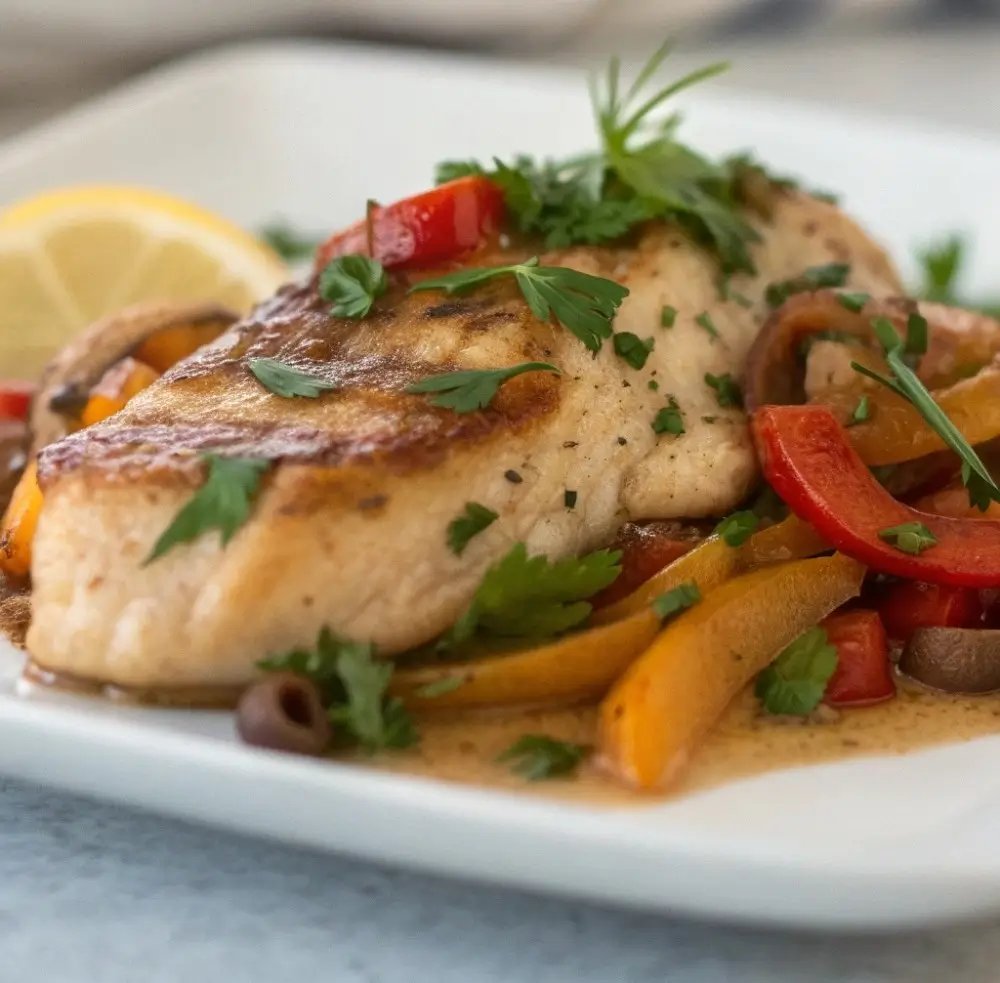Table of Contents
If you’re unfamiliar with Ahi tuna or looking for a great Ahi tuna recipe – seared, you’re in for a treat. This delicious fish is a game changer in the world of seafood. Also known as Yellowfin tuna, Ahi tuna is commonly used for sushi, poke bowls, and, of course, searing. The name “Ahi” comes from the Hawaiian word for fire, which makes sense because when it’s cooked right, the rich pink flesh and slightly charred exterior truly shine.
Ahi tuna is prized for its lean meat, mild flavor, and beautiful red-pink hue. The texture is firm yet tender, making it perfect for quick cooking methods like searing, grilling, or even a light sauté. Because of its high protein content and abundance of omega-3 fatty acids, Ahi tuna is not only tasty but also packs a nutritional punch. Whether you’re preparing it for a light meal or a special occasion, it never fails to impress.
What’s even better is that Ahi tuna is incredibly versatile. It pairs beautifully with fresh vegetables, grains, or even tropical fruits like mango and avocado. Plus, it cooks quickly—so you can create a restaurant-quality dish at home. But before you dive into cooking, let’s take a closer look at the Ahi tuna itself. Understanding what makes it so special will help you get the most out of your cooking experience.
What is Ahi Tuna?
If you’re just getting into seafood or looking for a new favorite fish, Ahi tuna is definitely one to try. But what exactly is Ahi tuna? Well, Ahi is a term used for two specific species of tuna: Yellowfin and Bigeye tuna. Both are known for their bright red flesh, which makes them a popular choice for sushi and seared dishes.
- Yellowfin Tuna: The most common type of Ahi tuna, Yellowfin has a lighter pink color and a slightly milder flavor. It’s commonly used in dishes like seared Ahi tuna and poké bowls due to its delicate texture.
- Bigeye Tuna: Bigger and fattier than Yellowfin, Bigeye tuna tends to have a deeper, richer flavor and is often preferred for sashimi or raw preparations. While it’s not as widely used for searing, it’s still a great option if you prefer a richer taste.
While these two species share the Ahi name, they do have some notable differences, particularly in flavor and texture. Yellowfin tends to be leaner, while Bigeye has a bit more fat, which makes it richer and more buttery when cooked. Both are fantastic choices, but understanding the distinction can help you make a better choice depending on the dish you’re preparing.
Nutritional Value of Ahi Tuna
When it comes to nutritional value, Ahi tuna is a powerhouse. It’s packed with high-quality protein, which makes it an excellent choice for those following a healthy, high-protein diet. A single serving of Ahi tuna can provide you with about 20 grams of protein—perfect for fueling your day.
But it doesn’t stop there! Ahi tuna is also rich in omega-3 fatty acids, which are crucial for heart health and reducing inflammation. These essential fats are the reason why this fish is often touted as one of the healthiest seafood options out there. On top of that, Ahi tuna offers a solid amount of essential vitamins and minerals, including B-vitamins, selenium, and potassium, which support overall well-being.
Choosing the Right Ahi Tuna Recipe -Seared
When you’re at the market looking for Ahi tuna, there are a few important things to consider. First, you’ll want to choose between wild-caught and farmed options.
- Wild-Caught Ahi Tuna: Often considered the better choice due to its natural diet and the absence of antibiotics or hormones, wild-caught tuna tends to have a firmer texture and a cleaner, more authentic flavor. It’s ideal for searing as it holds up well to high heat.
- Farmed Ahi Tuna: While it may be more affordable, farmed tuna can have a milder flavor and a slightly fattier texture. It’s also essential to ensure that the farmed tuna you choose is sustainably sourced.
To pick the best Ahi tuna for your seared recipe, look for fresh, bright red flesh that isn’t too dry or slimy. The fish should have a clean, ocean-like scent—if it smells too fishy, it might not be the best quality. And don’t forget to ask the fishmonger about the sustainability of the catch if that’s something that’s important to you!
Preparing Ahi Tuna Recipe -Seared Dishes
Once you’ve picked out the perfect Ahi tuna for your seared dish, it’s time to prep it for cooking. Preparation is key when it comes to ensuring that your tuna turns out tender and flavorful.
Thawing Frozen Tuna (If Necessary)
If you’ve bought frozen Ahi tuna, the first thing you’ll need to do is thaw it properly. The best way to thaw frozen fish is by placing it in the fridge overnight. This slow method helps maintain the tuna’s texture and flavor. If you’re short on time, you can also thaw it in a sealed bag under cold running water. Avoid using hot water or the microwave, as this can ruin the texture of the fish.
How to Properly Slice Ahi Tuna (Steaks or Fillets)
For a seared dish, you’ll typically want to slice your Ahi tuna into steaks or fillets. Depending on your recipe, you may want thinner slices for serving in salads or poké bowls, or thicker cuts for a steak-like presentation. When slicing, make sure to cut against the grain of the fish to ensure each slice remains tender. A sharp knife is crucial here—don’t settle for anything dull!
If you’re planning to use Ahi tuna in a seared steak recipe, aim for slices about 1-inch thick. This thickness will allow for a perfect sear on the outside while keeping the center nice and rare.
The Importance of Patting the Tuna Dry Before Cooking
Before cooking, one of the most important steps is to pat the Ahi tuna dry with a paper towel. Excess moisture can prevent the fish from searing properly and may result in a soggy texture. A good sear requires the fish to come into direct contact with the pan, so getting rid of any surface moisture is essential. The dryer the surface, the better your sear will be!
Seasoning the Ahi Tuna
Now that your tuna is prepped, it’s time to think about seasoning. When it comes to searing Ahi tuna, simple is often best. You can’t go wrong with the classics:
- Sea Salt and Black Pepper: These two ingredients will enhance the natural flavors of the tuna without overpowering it. Keep it light—Ahi tuna has such a clean flavor that you don’t want to mask it.
- Sesame Seeds: For an added crunch and a more Asian-inspired dish, consider rolling the tuna in sesame seeds. This gives your tuna a beautiful crust that’s both flavorful and texturally interesting.
The Impact of Marinating vs. Seasoning Just Before Cooking
While marinating Ahi tuna isn’t necessary for a seared dish, it’s certainly an option if you’re looking to add depth of flavor. If you do choose to marinate, be sure not to leave the tuna in the marinade for too long—15 to 30 minutes is all it needs. Marinating for too long can change the texture of the fish, making it mushy. On the other hand, seasoning just before cooking ensures that the tuna retains its fresh, natural flavor.
Optional Coatings (Sesame Crust, Black Pepper Crust, etc.)
For those looking to elevate their seared Ahi tuna game, coatings like a sesame crust or black pepper crust can add extra flavor and texture. A sesame crust, in particular, is a popular choice and pairs wonderfully with a light soy dipping sauce. Alternatively, a cracked black pepper crust can give the tuna a bit of a spicy kick, making it even more irresistible.
Step-by-Step Guide to Seared Ahi Tuna
When it comes to cooking Ahi tuna, searing is the way to go if you want a beautiful contrast between a lightly cooked exterior and a rare, tender center. In this section, we’ll walk you through a foolproof recipe for seared Ahi tuna that will have you feeling like a professional chef.
Ingredients for Seared Ahi Tuna
Before you start cooking, make sure you have everything ready. Here’s what you’ll need:
- Ahi tuna steaks (about 1 inch thick)
- 2 tablespoons of olive oil or avocado oil (for high heat)
- Salt and freshly ground black pepper (to taste)
- Sesame seeds (optional, for crusting)
- Crushed black pepper (optional, for crusting)
- Soy sauce (for dipping, optional)
- Fresh lemon or lime (optional, for zest)
Once you have all your ingredients, you’re ready to start!
Instructions for Cooking Seared Ahi Tuna
Now that you’ve prepped your Ahi tuna and gathered the ingredients, it’s time to sear this beautiful fish to perfection. Follow these simple steps:
- Prepare the Pan for Searing: Start by heating a heavy-duty skillet or cast iron pan over medium-high heat. You want the pan to be hot but not smoking. Add 1-2 tablespoons of olive oil to the pan and allow it to heat up for a minute or two. The oil should shimmer, but it shouldn’t be smoking.
- Season the Tuna: While the pan is heating, season your Ahi tuna steaks generously with sea salt and freshly ground black pepper. If you’re using sesame seeds or crushed black pepper, lightly press them onto the surface of the tuna to form a crust.
- Sear the Tuna: Place your Ahi tuna steaks in the pan, making sure they’re not overcrowded. You should hear a satisfying sizzle as they hit the hot pan. Sear the tuna for 1.5 to 2 minutes per side for a perfect medium-rare finish. The exact time will depend on the thickness of the tuna, but the goal is to get a beautifully brown and crisp crust on the outside while keeping the inside tender and rare.
- Flip the Tuna: Using tongs or a spatula, gently flip the tuna after 1.5 to 2 minutes. Avoid pressing down on the fish with your spatula—it’s tempting, but you want to retain the juice inside. The tuna should have a golden brown sear on both sides, with the middle staying rare.
- Rest the Tuna: After searing both sides, remove the tuna from the pan and place it on a cutting board. Allow it to rest for a few minutes. This step ensures that the juices redistribute inside the tuna, keeping it moist and tender.
- Serve: Slice the Ahi tuna against the grain, and serve immediately with a side of soy sauce, mango salsa, or a fresh avocado salad.
Tips for Perfect Seared Ahi Tuna
If you’re aiming for that perfect, restaurant-quality sear, here are some tips to keep in mind:
- Ensure Even Searing: To get an even sear, make sure the pan is fully preheated before you add the tuna. Avoid moving the tuna around in the pan once it’s in place. Let it sit undisturbed to form a crisp, golden crust.
- Know When to Flip: Timing is everything when it comes to searing. You want to flip the tuna only once. The first side should sear for around 1.5 to 2 minutes, depending on the thickness of your tuna steak. Use tongs to gently lift the tuna and check the color on the seared side—if it’s golden brown, it’s time to flip!
- Don’t Overcook: Ahi tuna is best served medium-rare. If you leave it on the pan for too long, it will lose its tender texture and become dry. Aim for a sear that leaves the center rare with a warm pink interior.
- Resting Is Key: Letting the tuna rest after searing ensures it remains juicy and moist. It also allows the flavors to settle before you slice it.
Different Cooking Techniques for Ahi Tuna
While pan-searing is the most popular method for cooking Ahi tuna, there are a few other techniques you can experiment with to get a unique twist on your dish.
- Pan-Searing vs. Grilling: Both pan-searing and grilling are excellent ways to cook Ahi tuna. Grilling imparts a smoky flavor and charred texture that can be really delicious, especially in the summer months. However, pan-searing gives you more control over the temperature and ensures that the fish doesn’t dry out. For a more traditional, tender texture, I recommend sticking to the pan-searing method.
- Optional Cooking Tools: If you want to take it up a notch, using a cast iron skillet is an excellent choice. Cast iron provides even heat distribution, allowing you to achieve a perfect sear without hot spots. If you don’t have a cast iron pan, a regular non-stick skillet or a grill pan will also work just fine.
Remember, whichever method you choose, the key is to cook the tuna quickly and avoid overcooking to preserve its delicate texture and flavor.
Best Flavor Pairings for Seared Ahi Tuna
One of the best things about Ahi tuna recipe -seared is its versatility when it comes to flavor pairings. Whether you’re in the mood for something fresh and light or want to go bold and savory, there’s no shortage of delicious options to complement this flavorful fish.
Fresh Accompaniments
When it comes to pairing fresh ingredients with your Ahi tuna, simplicity often works best. Fresh fruits, crisp vegetables, and vibrant herbs will brighten up the dish and bring out the natural flavors of the tuna. Here are a few of my top picks:
- Sliced Avocado: The rich, buttery texture of avocado makes it the perfect pairing for the tender Ahi tuna. The cool creaminess contrasts beautifully with the seared, warm tuna.
- Cucumber Salad: A light, refreshing cucumber salad with a hint of vinegar or lime provides a perfect balance to the rich taste of the tuna. Add a sprinkle of sesame seeds for extra crunch!
- Mango Salsa: For a tropical twist, mango salsa offers a sweet contrast to the savory tuna. The slight sweetness of ripe mango, combined with a dash of lime and cilantro, will have your taste buds dancing.
Sauces and Dips
To take your Ahi tuna recipe -seared to the next level, don’t forget about sauces and dips. A good sauce can elevate the dish and add another layer of flavor. Here are a few great options:
- Soy Sauce-Based Dipping Sauce: A classic pairing for Ahi tuna, this salty and umami-rich dip will accentuate the tuna’s flavor. Try adding a touch of ginger or garlic for an extra kick.
- Wasabi Mayo: For a bit of heat, mix some wasabi with mayonnaise to create a creamy, spicy dip. It’s perfect for adding a bold flavor contrast to the tuna.
- Citrus Vinaigrette: A light citrus vinaigrette made with lemon or lime juice can add a zesty punch that complements the richness of the fish without overwhelming it.
Side Dishes to Serve with Ahi Tuna
For a well-rounded meal, pair your seared Ahi tuna with some delicious side dishes. Here are a few options that will complete your plate:
- Simple Salad Options: A light salad with greens like arugula or mixed greens can be the perfect side. Toss in some cherry tomatoes, a few slivers of red onion, and a light vinaigrette dressing.
- Grilled Vegetables: Grilled veggies like asparagus, bell peppers, and zucchini are a perfect complement to the bold flavor of the tuna. Their smoky flavor and tenderness enhance the overall dish.
- Rice Bowls: A rice bowl can be a great option if you’re craving something more filling. You can add a base of jasmine or brown rice, and top it with the Ahi tuna and fresh toppings like avocado, cucumber, and a soy-based dressing.
How to Serve Ahi Tuna for Special Occasions
When you’re serving Ahi tuna for a special occasion, presentation can make a big difference. A beautiful plate will impress your guests just as much as the taste!
- Plating Tips for an Elegant Presentation: For a clean, restaurant-style look, slice your Ahi tuna into thin strips and fan them out across the plate. Garnish with a few sprigs of fresh herbs like cilantro or parsley, and drizzle with your favorite sauce or vinaigrette. Serve on a white or black plate to make the colors of the tuna and toppings pop.
- Serving Ahi Tuna as Part of a Sushi Platter or Salad: If you’re making Ahi tuna for a party or gathering, consider serving it as part of a larger sushi platter or salad. A colorful assortment of fresh fish, pickled vegetables, and sauces will give your guests a variety of flavors to enjoy. It’s an excellent way to share the love of Ahi tuna while making your meal feel like a celebration!
FAQs on Seared Ahi Tuna
What is the best type of tuna for searing?
When it comes to searing Ahi tuna, both Yellowfin tuna and Bigeye tuna are excellent choices. However, Yellowfin tuna is the most common and widely available for searing due to its lean texture and mild flavor. It’s perfect for achieving that beautiful sear on the outside while keeping the center rare and tender. Bigeye tuna, which has a slightly higher fat content, will offer a richer flavor but may be a bit less lean. Both types of Ahi tuna have firm flesh, making them ideal for searing, so it really depends on your flavor preference.
Can I cook Ahi tuna well-done?
While Ahi tuna can technically be cooked well-done, it’s not recommended, especially for seared dishes. The fish’s texture and flavor are at their best when served medium-rare, with a slightly crisp exterior and a tender, pink interior. Overcooking Ahi tuna can cause it to become dry and lose its delicate, buttery texture. If you prefer it more cooked, you can adjust the searing time, but aim to avoid going beyond medium doneness. A thermometer can help you check the internal temperature—130°F is ideal for medium-rare.
How do I store leftover seared Ahi tuna?
If you have leftovers, storing them properly will help maintain their quality. To store seared Ahi tuna, place the fish in an airtight container and refrigerate it for up to 1-2 days. Make sure to let it cool completely before sealing it to prevent moisture buildup. When reheating, use low heat to avoid drying it out, or serve it cold in a salad or bowl to maintain its tender texture.
Can I make this recipe ahead of time?
While Ahi tuna is best when fresh, you can prepare certain elements of the dish ahead of time. You can pre-slice and season the tuna, but it’s best to sear it just before serving for the perfect texture. To keep it fresh, store the tuna in the fridge and cook it no more than an hour before serving. If you’re serving a large meal, pre-searing and then finishing the tuna in a warm oven for a couple of minutes can be a helpful strategy.
Looking for more seafood dishes? Check out this guide to delicious tuna recipes.
Variations of Ahi Tuna Recipe -Seared
While the classic Ahi tuna recipe -seared is delicious on its own, there are plenty of creative variations you can try to mix things up and bring in new flavors. Here are a few exciting options:
Seared Ahi Tuna with a Sesame Crust
For a crunchy, nutty twist, try making a sesame crust for your Ahi tuna. Coat the tuna steaks in sesame seeds—either black, white, or a mix—before searing. The sesame seeds will create a delicious, crispy exterior that contrasts beautifully with the tender, rare interior of the fish. Not only does it enhance the texture, but it also adds a mild, earthy flavor that pairs wonderfully with soy-based sauces or a light citrus vinaigrette. This variation is perfect for anyone who loves a bit of crunch in their seafood.
Ahi Tuna Poke Bowl
If you’re craving a lighter, refreshing dish, try incorporating seared Ahi tuna into a poke bowl. Begin by slicing the seared tuna into bite-sized cubes and layering it over a bowl of rice. Add fresh toppings like sliced avocado, cucumber, edamame, seaweed, and radish. Drizzle with a soy sauce-based dressing and garnish with sesame seeds. The result is a vibrant, satisfying bowl that perfectly blends the flavors of seared Ahi tuna with fresh, crunchy vegetables.
Spicy Seared Ahi Tuna
For those who enjoy a kick, adding a spicy twist to your Ahi tuna is a fantastic option. You can season the tuna with chili flakes or marinate it in a sriracha-based sauce before searing. This will infuse the fish with a zesty, spicy flavor that complements the natural richness of the tuna. A spicy tuna steak can also be served with a side of cooling avocado or cucumber salad to balance out the heat.
Conclusion
Cooking Ahi tuna recipe -seared at home is not only a rewarding experience, but it’s also a great way to enjoy a healthy, flavorful meal that rivals restaurant-quality dishes. The beauty of searing Ahi tuna lies in its simplicity. With just a few ingredients and some careful attention to timing, you can create a perfectly cooked piece of fish with a crisp exterior and a tender, rare interior. Whether you stick to the classic seasoning or get creative with coatings like sesame crust or spicy marinades, the possibilities are endless.
One of the best things about seared Ahi tuna is its versatility. Don’t be afraid to experiment with different seasonings, toppings, and pairings. From adding a mango salsa or a soy dipping sauce to serving the tuna in a poke bowl, there are countless ways to tailor this dish to your tastes. For a more adventurous twist, try a spicy seasoning or even mix it into salads for a light, refreshing meal.
Not only is Ahi tuna delicious, but it’s also packed with health benefits. It’s high in protein, omega-3 fatty acids, and essential vitamins, making it a smart choice for anyone looking to enjoy a nutritious yet indulgent meal.
So, whether you’re cooking for a weeknight dinner or planning a special occasion, seared Ahi tuna is an excellent option. It’s simple, healthy, and packed with flavor—what’s not to love? Happy cooking!





